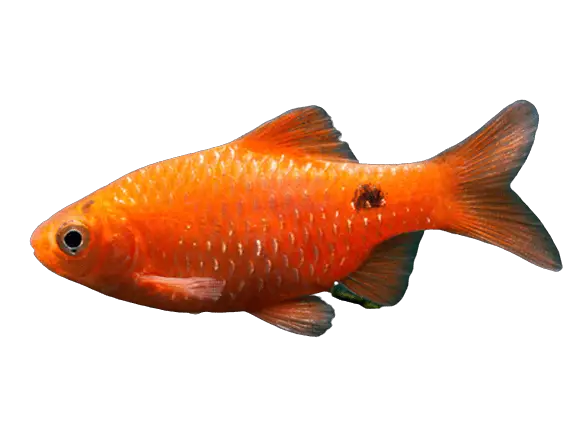The rosy barb is an extremely prominent aquarium fish among the pet fish enthusiasts because of its splendid body tinge and strength. In 1822, it was first discovered by well known zoologist and botanist Dr Francis Buchanan. It is a cyprinid fish under carp family (Cyprinidae) of order Cypriniformes. This barb is listed as Least Concern (LC) on the IUCN Red Data Book.
Systematic Position
Distribution and Habitat
In nature, it is found in Bangladesh, Nepal, India, Afghanistan, and Pakistan. At present, it has introduced in Singapore, Mexico, Australia, Columbia and Puerto Rico as an aquarium fish. It occupies little waterways, slope streams, lakes, ditches, ponds and swamps where still waters are available.
Common Name
It is a very charming aquarium fish which is also called Red Barb, Rose Barb, Rosie Barb, and so on.
Body Shape
The rosy barb is very popular with freshwater aquarists. Its body is elongated and horizontally packed with forked tail fin and erect dorsal fin. The mouth is little and terminal.

Body Colors
Body has coppery pink or shiny hues however along the back, greenish shed is available. Along the upper edges of the dorsal and anal fins, some dark shades are seen. A dark stamp is also present at the base of the caudal peduncle.
Body Size and Lifespan
It can grow up to 15 cm long with a life expectancy of up to 5 years or increasingly if appropriate care is taken.
Quick Rosy Barb Facts
Food and Feeding Behavior
It is omnivorous fish and its nourishment comprises of plant matters and substantial sustenance like crustacean zooplankton, worms, insects and its hatchlings. It additionally takes frozen nourishments like Daphnia, Artemia or brine shrimp, bloodworms and mosquito hatchlings etc.
To keep your fish upbeat, plant based sustenance, for example, Spirulina, lettuce, spinach with chips should be offered. Feed should be given 2-3 times with little amount to prevent food waste.
Housing and Care Facts
It is an extremely peaceful fish and it requires no less than 25 gallon tank yet bigger is prescribed. The tank should have filtration system and active water movement with adequate aquarium plants. In this case, Java moss does well however delicate or soft leaved plant should be avoided because they have nibbling behavior.
It is a dynamic jumper; to prevent jumping out, you should use cover or lid on the top of the aquarium. It additionally prefers good water quality with a pH of 6.0-8.0, hardness of 8-12 dGH and temperature of 65 – 75 degrees F. To make your tank condition sound, tank water should be changed each other week.
Tank-mates
It is a community fish and it can be kept in groups. At least 5 individuals are kept together. Best tank-mates incorporate Freshwater Angels, Swordtails, Knifefish, Gouramis, Paradise fish, Tetras, Danios, Chinese Algae Eater, Platies, Loaches, Mollies, Rainbow Shark, Red Tailed Shark, Silver Dollar etc. Siamese battling fish and Guppies should be avoided as a tank mates because of their forceful conduct.
Breeding Behavior
It is an egg layers and it can breed in hostage condition if suitable care is taken. For successful reproduction, it needs no less than 10 gallon tank with great filtration system. In this case, you should use best aquarium filter to make clean water in your aquarium. The breeding tank should have floating plants, course rock or marbles.
The mature female lays around 100 eggs per spawning. After spawning, parents should be transferred to another tank to prevent eating the eggs. The eggs hatch within 30 hours and the fry become free swimming following 6 days. The baby fish should be fed with infusoria, recently hatched brine shrimp, and any fluid fry nourishment. Feed should be given 3 times a day.
Male and Female Sex Differences
At the adolescent stage, it is difficult to make contrasts between the male and female. Male is blushing pinkish in shading with dark tipped fins while the female body is silver to yellowish in hues with brighter fins.
Disease and Preventive Measures
Rosy barb is a very hardy fish but sometimes it is affected by ich ( a protozaon parasitic disease) due to inappropriate tank management. To make your fish disease free, good water quality and proper tank management should be maintained. In this case, water changes should be done each other week. You should also provide balanced diet to make your fish healthy and happy.
Concluding Remarks
The Rosy Barb is an extremely alluring and prevalent fish among the aquarium devotees because of splendid body hue and hardiness. It is presently available in the pet fish market and online shops with sensible cost. To make your aquarium more alluring, we prescribe you to keep this lovely fish in your tank.
